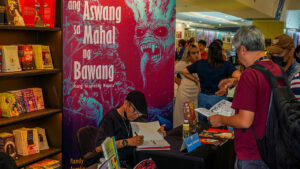PHILIPPINE COMICS once dominated the country’s bookshelves, especially during the 1950s and 1960s — an era often dubbed the comics’ “Golden Age.” It was a time when readership soared into the millions and more than 40 titles hit newsstands each week.
It was a cultural phenomenon, one that introduced generations of readers to classic Filipino comics artists like the late Francisco V. Coching, National Artist for Visual Arts and long revered as the “King of Komiks,” as the word was spelled here.
And who could forget Mars Ravelo, whose works like Darna and Captain Barbell are still considered cultural icons, having been adapted into various films and television series across generations.
But as the page turned from the 1970s to the 1990s, the dominance of Filipino comics declined due to various factors, such as censorship during the Martial Law era, the brain drain of local artists, the influx of foreign comics, and the increased accessibility of other media like television.
One by one, major comic book publications such as Pilipino Komiks, Hiwaga Komiks, and Tagalog Klasiks ceased operations. The works of Filipino comics masters also gradually faded from public awareness.
But there is a renewed effort to revive the works of classic Filipino comics artists through the recent launch of Grafika, one of two new imprints from the Vibal Foundation, alongside Agimat Comics, during the second day of the Philippine International Comics Festival (PICOF) 2025 last Sunday.
Mr. Coching’s works like Condenado, Satur, and Dumagit have been republished and are now more accessible to comics enthusiasts and aspiring artists.
“Unang-una, if you’re an artist — a Filipino artist — kailangan malaman mo yung mga old masters natin na you might not be aware of (First of all, if you’re an artist — a Filipino artist — you need to know our old masters, whom you might not be aware of),” Randy Valiente, editor-at-large of Grafika, told BusinessWorld on the sidelines of PICOF.
“It’s not necessary to copy their style, but at least you need to be aware of who the veterans in comics are,” he added.
With nearly 30 years in the comics industry, Mr. Valiente has found a renewed sense of purpose in reviving the works of our comic legends — whose creations are now relatively unseen by younger generations.
“Lumilipas ’yung mga araw, parang nare-realize ko, ‘Teka, what if hukayin ko ’yung mga lumang komiks talaga at ’yun ang ilabas?’ Kasi nga, may mga opportunity na ngayon ’yung mga bata to publish their own thing (As days passed, I started to realize, ‘Wait, what if I dig up the old comics and bring them back out?’ After all, young people today already have opportunities to publish their own work),” Mr. Valiente said.
“For us, ’yung mga old comics, wala naman nagpo-propose dun eh (For us, no one really proposes anything about the old comics),” he added.
Among the titles published under Grafika is Nagalit ang Aswang sa Mahal ng Bawal, a gritty and socially charged graphic novel by Mr. Valiente and Aurelio Castro III that reimagines the mythical aswang as a powerful metaphor for contemporary social unrest.
Mr. Valiente said that they are also working to republish Kabalbalan ni Kenkoy by Tony Velasquez, the country’s first comic strip, originally published in 1929.
Another highlight of the PICOF event was the launch of Agimat Comics, a new imprint from Vibal Foundation that features talismanic tales from around the world.
“I chose the name Agimat Comics because each book is like a talisman with divine light or divine wisdom, and it would shed light on how far comics can go,” Paolo Herras, PICOF’s festival director and co-founder of Komiket told BusinessWorld.
Among the titles under Agimat Comics are the autobiographical comics Fried Rice by Erica Eng (Malaysia) and Long Distance Call by Sheree Domingo (Philippines/Germany), as well as the award-winning Cockman by Kenfoo (Singapore). — Edg Adrian A. Eva
